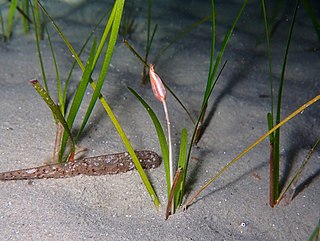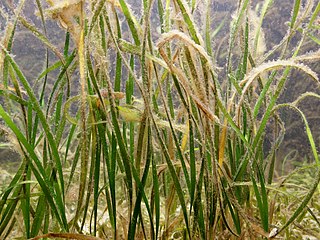
The Caribbean Sea is a sea of the Atlantic Ocean in the tropics of the Western Hemisphere. It is bounded by Mexico and Central America to the west and southwest, to the north by the Greater Antilles starting with Cuba, to the east by the Lesser Antilles, and to the south by the northern coast of South America. The Gulf of Mexico lies to the northwest.

Seagrasses are the only flowering plants which grow in marine environments. There are about 60 species of fully marine seagrasses which belong to four families, all in the order Alismatales. Seagrasses evolved from terrestrial plants which recolonised the ocean 70 to 100 million years ago.

A seagrass meadow or seagrass bed is an underwater ecosystem formed by seagrasses. Seagrasses are marine (saltwater) plants found in shallow coastal waters and in the brackish waters of estuaries. Seagrasses are flowering plants with stems and long green, grass-like leaves. They produce seeds and pollen and have roots and rhizomes which anchor them in seafloor sand.

Johnson's seagrass is a small, asexual seagrass in the family Hydrocharitaceae. It has been called Halophila johnsonii, but is now considered to be a clone of the widespread species Halophila ovalis. As of March 2024, Plants of the World Online treats Halophila johnsonii as a synonym of Halophila ovalis subsp. ovalis. Johnson's seagrass occurs only on the southeastern coast of Florida, in lagoons along roughly 200 km of the Florida coastline between Sebastian Inlet and the northern part of Biscayne Bay, where it grows in small patches of a few centimeters to a few meters in diameter at depths ranging from the intertidal zone down to 3 meters. It was the first marine plant listed on the United States endangered species list, though it was removed from the listing in April 2022.

Halophila is a genus of seagrasses in the family Hydrocharitaceae, the tape-grasses. It was described as a genus in 1806. The number of its contained species, and its own placement in the order Alismatales, has evolved.

Halophila ovalis, commonly known as paddle weed, spoon grass or dugong grass, is a seagrass in the family Hydrocharitaceae. It is a small herbaceous plant that naturally occurs in sea beds and other saltwater environments in the Indo-Pacific. It was introduced as isolated populations in Florida, Cuba and Antigua.
The Seagrasses of Western Australia are submerged flowering plants found along the coast, around islands, and in Estuaries of Western Australia. The region contains some of the largest seagrass meadows in the world, and is the most diverse in the number of species. The variety of habitats along its western and southern coasts is often soft sands in shallow subtropical waters, ideal for these plants.

Thalassia testudinum, commonly known as turtlegrass, is a species of marine seagrass. It forms meadows in shallow sandy or muddy locations in the Caribbean Sea and the Gulf of Mexico. Turtle grass and other seagrasses form meadows which are important habitats and feeding grounds. The grass is eaten by turtles and herbivorous fish, supports many epiphytes, and provides habitat for juvenile fish and many invertebrate taxa.

Cymodocea nodosa is a species of seagrass in the family Cymodoceaceae and is sometimes known as little Neptune grass. As a seagrass, it is restricted to growing underwater and is found in shallow parts of the Mediterranean Sea and certain adjoining areas of the Atlantic Ocean.

Elysia catulus is a small species of sea slug, a marine gastropod mollusc in the family Plakobranchidae. This sea slug resembles a nudibranch, but it is not closely related to that order of gastropods, instead it is a sacoglossan. The specific name "catulus" comes from the Greek and means "little cat", referring to the superficial resemblance that the head of this slug bears to the head of a cat.
Elysia serca, the seagrass elysia or Caribbean seagrass elysia, is a species of sea slug, a marine gastropod mollusc in the family Plakobranchidae. Although this sea slug resembles a nudibranch, it is not a nudibranch; it belongs to the clade, Sacoglossa, the "sap-sucking" sea slugs. It was first described by Marcus in 1955 from specimens found in Brazil.

Halophila decipiens, commonly known as Caribbean seagrass or paddle grass, is a seagrass in the family Hydrocharitaceae. It grows underwater on sandy or muddy sea floors in shallow parts of tropical seas.

Syringodium filiforme, commonly known as manatee grass, is a species of marine seagrass. It forms meadows in shallow sandy or muddy locations in the Caribbean Sea and the Gulf of Mexico, and is also found in the Bahamas and Bermuda. It occurs to a depth of about 20 m (66 ft), and even deeper where water is very clear.

Halodule wrightii is an aquatic plant in the Cymodoceaceae family. It is referred to by the common names shoal grass or shoalweed, and is a plant species native to seacoasts of some of the warmer oceans of the world.

Zostera noltii is a species of seagrass known by the common name dwarf eelgrass. It is found in shallow coastal waters in north western Europe, the Mediterranean Sea, Black Sea, Caspian Sea and Aral Sea and on islands in the Atlantic off the coast of northwest Africa. It is an important part of the intertidal and shallow subtidal ecosystems of estuaries, bays and lagoons.

Halodule uninervis is a species of seagrass in the family Cymodoceaceae. It is native to the western Pacific and Indian Oceans. Common names include narrowleaf seagrass in English and a'shab bahriya in Arabic.

Thalassodendron ciliatum, the sickle-leaved cymodocea, is a species of plant in the Thalassodendron genus of seagrasses in the family Cymodoceaceae.
Halophila baillonis is a species of aquatic plant in the family Hydrocharitaceae. It is referred to by the common name clover grass. It is native to Brazil, Cayman Islands, Colombia, Costa Rica, Jamaica, Leeward Islands, Netherlands Antilles, Panama, Puerto Rico, Trinidad and Tobago, and Venezuela. It is listed on the IUCN Red List as "vulnerable" due to its naturally rare occurrence and fragmented populations.

The Big Bend Coast is the marshy coast extending about 350 kilometres (220 mi) from the western end of Apalachee Bay down the west coast of peninsular Florida to the Anclote River or Anclote Key. It partially overlaps the coast line of the Big Bend region of Florida, and is coterminous with the coast line of the Nature Coast region of Florida. Most of the coast remains undeveloped, with extensive salt marshes, mangrove forests, seagrass meadows, and oyster reefs offshore, and coastal hammocks onshore.

Electra posidoniae is a species of bryozoan in the family Electridae. It is endemic to the Mediterranean Sea, and is commonly known as the Neptune-grass bryozoan because it is exclusively found growing on seagrasses, usually on Neptune grass, but occasionally on eelgrass.


















